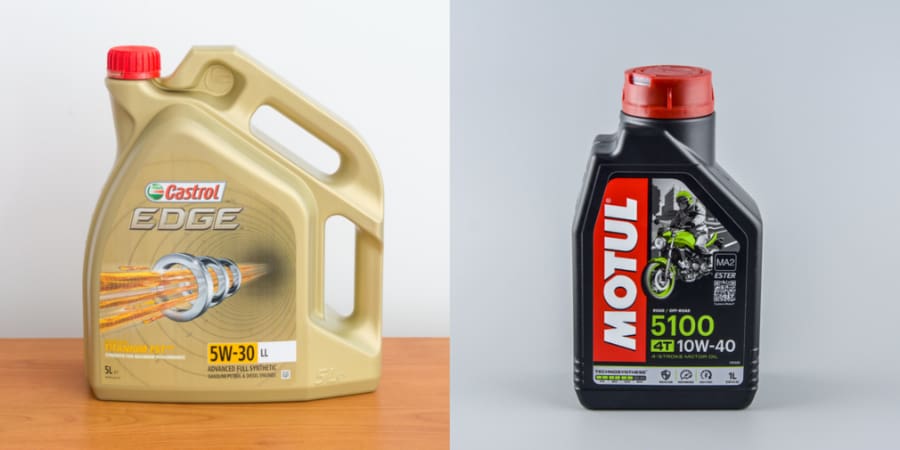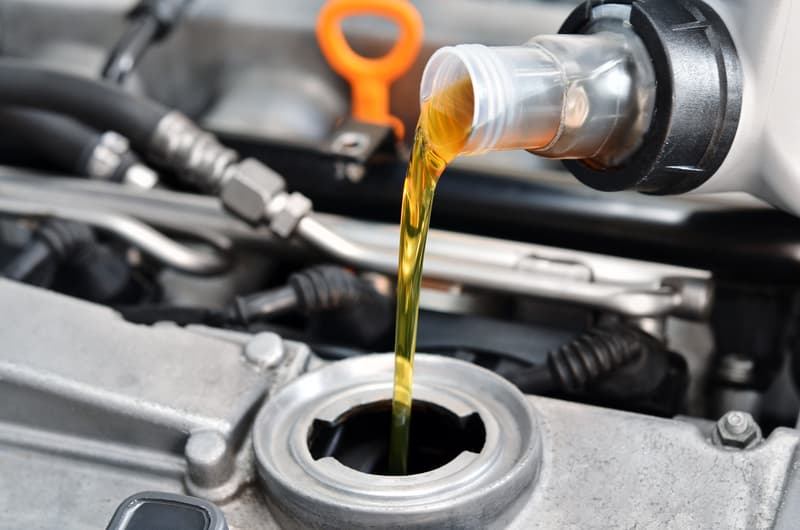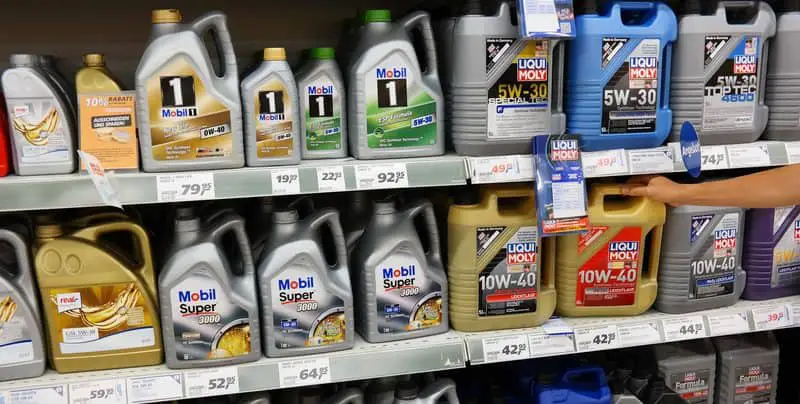
Everyone has been there—you need to change your vehicle’s oil, but you’re not sure which oil weight is suitable. Almost everyone who isn’t a mechanic has wondered if they could get away with using a slightly thicker oil in their engine. So, can you use 10W40 instead of 5W30?
You can use 10W40 instead of 5W30, but it is not recommended. 10W40 is a thicker oil, and may not flow easily in cold weather or provide much protection in hot weather as a thinner oil like 5W30. Regardless of climate, it is best to stick with the oil recommended by your car’s manufacturer.
In the rest of this article, I’ll explain why you should stick with your car’s recommended oil and what can happen if you don’t. I’ll also explore motor oil grade specifications, their purpose, and how they affect your car’s performance. Let’s get started!
What Will Happen If You Use 10W40 Instead of 5W30?
If you use 10W40 instead of 5W30, nothing will happen to the engine in the short term. However, using it for a prolonged period can result in faster engine wear and tear and corrosion.
Oil is measured by its thickness in viscosity index (VI) units. When there is more than one of these numbers (like 5W-30), it means that it performs best at two different temperatures: 5 (low temperatures) and 30 (higher temperatures).
Viscosity measures how easily a liquid flows, with lower numbers indicating thinner oils and more fluidity. This means that a 5W-30 oil has less viscosity than a 10W-40 oil, which in turn has less viscosity than a 15W-40.
In this case, W stands for winter, and the numbers represent oil thickness at 100°C (212°F). 5W-30 is, therefore, a thinner oil than 10W-40. Most engines will run when their oil temperature is between those two numbers.
Many cars can run for a while with a 10W-40 oil instead of a 5W-30 product. However, that doesn’t mean it’s a good idea. For example, let’s assume you decided to use 10W-40 in your 2010 Honda Civic EX. Although you’re aware that the optimal viscosity for this car is 5W-30, you decide to see what happens if you use 10W-40 anyway.
I’ll discuss the impact of using 10W40 instead of 5W30 in more detail below:
Short Term: Nothing Will Happen
While it’s technically possible that your engine won’t explode when you turn the ignition on and won’t cause any immediate damage, the reality is that it’s a bad idea.
That being said, the oil needs to be within a certain viscosity range (a measurement of how “thick” it is) to do its job properly.
When talking about a car or truck engine (as opposed to one in an industrial machine), the oil should be as thin as possible to allow for optimal flow and keep everything cooler.
The oil pump has been calibrated based on the viscosity of the oil, and if it’s too thick, it can’t get pumped around very well, leading to problems.
Long Term: Engine Wear and Corrosion
The other thing to consider with oils is their additives package. There are various kinds of additives in oil, all with different functions:
- Some help prevent corrosion
- Others effectively clean deposits out of the engine
- Others are designed to improve fuel economy and help keep the parts cooler by preventing them from overheating
If the oil is too thick, it won’t be able to effectively carry these additives through your engine, and they will eventually break down and stop working.
This means that your engine won’t have any protection against wear or corrosion – things that can seriously affect the performance and longevity of your vehicle.
However, if you notice white smoke coming from your diesel engine, it might not be related to the type of oil you use. There are several potential causes of diesel engine smoke, including:
- Incomplete combustion
- Poor fuel quality
- Excessive idling
What To Do if You Use 10W40 Instead of 5W30

If you mistakenly fill your car’s engine with 10W40 instead of the 5W30 synthetic oil specified in your owner’s manual, you don’t necessarily have to panic. You just need to know what to do next.
I’ll discuss this in more detail below:
Don’t Throw Away the Engine
First things first: if you’re thinking about replacing your engine due to the oil change mistake, stop. Although you’ll have to add another quart of synthetic oil to your car to bring its total up to the required amount, there’s no reason to give in to panic.
If your owner’s manual says that your car takes 5W30 oil, the chances are pretty good that it was designed for either type of oil.
Don’t Use 5W30 for a While
If you’re at all concerned about long-term effects (and let’s face it, if you don’t know what kind of oil goes in your car, you probably should be), don’t use 5W30 for a little while.
If buying more oil worries you because you don’t know how much the car uses, use 5W30 until you can get to an auto parts store and pick up some 10W40 or use an oil change service. You won’t hurt anything by doing this (unless you’re trying to run your engine on vegetable oil—don’t do that).
Listen to the Car
You may have to top up the level of your oil reservoir after driving it each time or every other time. This is because friction from the engine will burn off some of the oil.
You should also keep an eye on how things are sounding—but don’t worry too much about that unless something feels different from the nor.m.
The most likely thing that might happen is that the oil will get dirty faster due to its higher viscosity. However, this is nothing that would cause serious damage.
Use the Recommended Oil
Going forward, if you’re only using 10W-40, then at your next scheduled oil change, go back to using 5W-30 instead. You should also continue using 5W-30 from this point on.
In other words, if you were using 10W-40 for the past 200 miles and at 300 miles, you should switch back to 5W-30. Then, for the remaining 300 miles of your oil change schedule (600 total), you’ll be fine putting in 5W-30 instead.
The exception is if you have an older vehicle, such as certain Mercedes or BMW models with an engine designed to run on special oils. If you have one of those, stick with 10W-40 or 5W-30, and don’t switch up the viscosity too much.
Types of Motor Oil and Recommended Use

Before discussing the different types of engine oil, and their recommended use, it’s worth explaining what SAE grade means.
The SAE grade (or Society of Automotive Engineers Grade) is a term that is often printed on engine oil labels. If refers to a grading system for measuring engine wear protection as part of its J300 standard.
According to Pennzoil, the following are the most common types of motor oils:
Synthetic Oil
Synthetic oil is specially designed to protect your engine against extreme temperatures and uses special additives to clean and lubricate the engine. It also has a higher viscosity index than conventional oil and better retains its viscosity at extreme temperatures.
This means that your engine can run more efficiently and last longer. Synthetic oil is recommended for newer vehicles with advanced internal components that require the superior characteristics of synthetic oils.
Synthetic Blends
Synthetic blends combine synthetic and conventional oils, and have the advantage of both in one bottle. They provide extended drain intervals compared to conventional oils but don’t offer some of the benefits of full synthetic oils.
Synthetic blends are perfect for vehicles that spend most of their time driving around town instead of making long road trips or pulling heavy loads.
High Mileage Oil
If you’re looking for an inexpensive alternative to high-performance synthetic motor oil, you might want to consider a high-mileage oil. This type of motor oil is designed for vehicles that are driven under normal conditions with over 75,000 miles (120,000 km) on the clock.
They’re formulated with viscosity modifiers that help reduce friction in your engine, which can improve fuel economy by 1%-3%.
Conventional Motor Oil
Conventional oils are also made from crude oil, which means they naturally contain varying amounts of sulfur and other impurities. When these impurities are removed during the refining process, they can cause the finished product to be less stable than synthetic alternatives.
This instability causes an “oxidation” reaction, which means that the oil will break down over time into other compounds that aren’t pure hydrocarbons anymore.
Final Thoughts
I’m a big believer that your owner’s manual is the best place to start when troubleshooting any problem of this nature.
The bottom line is that you can put 10w40 in your car. Nevertheless, that’s not always the best idea, depending on the weather conditions and your local climate.
It may be easier to use the oil recommended in your owner’s manual (unless you like your car better when it’s always overheating).
If you’re wondering whether you can use 5W30 instead of 0W20, read this article.
